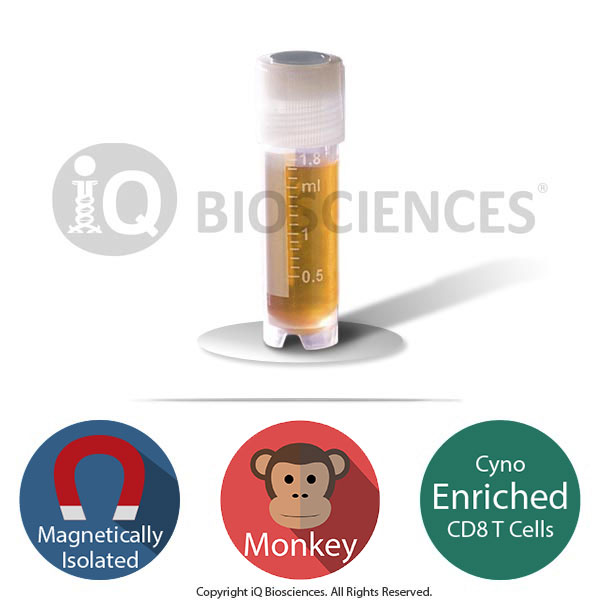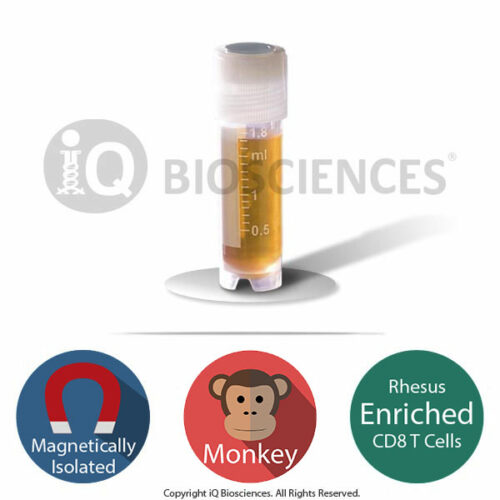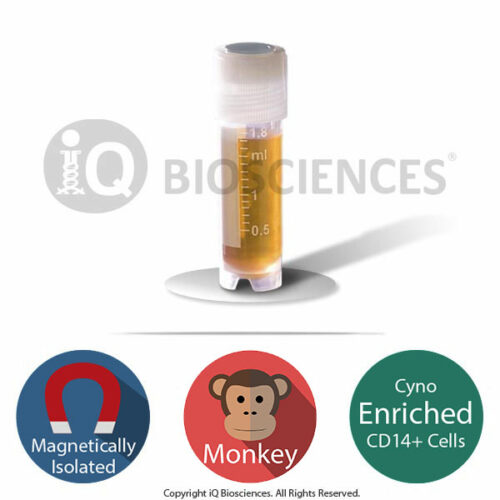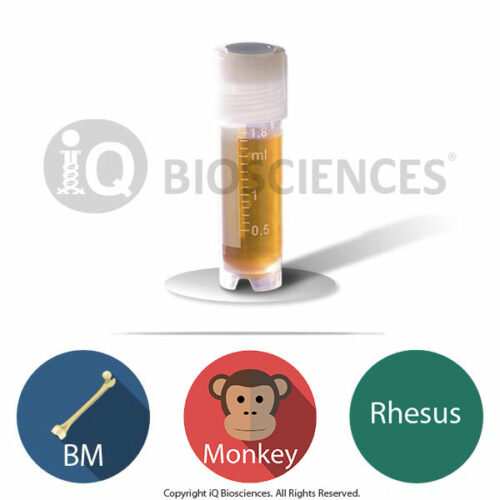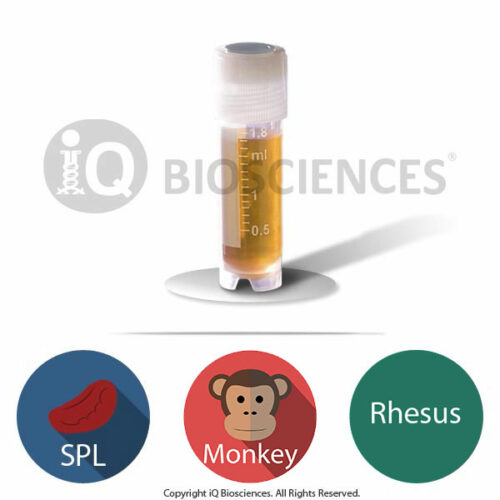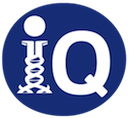- CD8 T cells purified from cynomolgus macaque PBMCs by magnetic selection
- Used for a wide variety of safety assessment and functional assays
- Carefully cryopreserved to ensure high viability (> 90%) upon thawing
- All orders come with an iQ Certificate of Analysis
Purified Cynomolgus Macaque Monkey CD8 T Cells
$1,190.00
- Description
- Additional information
- Donor Request
- Ethics
- iQ Experience
- Shipping Information
- Distributors
Description
About the Cynomolgus Monkey (or Cynomolgus Macaque)
The cynomolgus macaque is the most commonly utilized non-human primate in biomedical research. According to some researchers, these monkeys are ideal models due to the 90-93% genetic similarity to and recent evolutionary divergence from humans. They are employed in numerous research areas, such as immunology, neuroscience, oncology, diabetes, and pharmacology due to their genetics and physiology.
Cynomolgus Macaque Monkey CD8 T Cells
Cynomolgus CD8 T cells make up approximately 8-28% of PBMCs in a typical adult monkey. These cells carry the CD8 protein marker and the T cell receptor (TCR), which recognizes foreign antigens presented by major histocompatibility complex class I molecules on antigen presenting cells to activate them.
CD8 T cells develop in the thymus to become mature T cells and exit the thymus to reside and encounter foreign pathogens in lymphoid tissues.
When activated, CD8 T cells become cytotoxic cells that can lyse infected or transformed cells.
CD8 T Cell Application Summary
Purified cynomolgus CD8 T cells are a good source of cells to study the biology of CD8 T cells and their role in the immune system. They can be used for a variety of stimulation-dependent functional experiments to assess cytotoxicity and proliferation.
With the current trend toward development of immuno-modulatory drugs, purified cynomolgus CD8 T cells are an ideal source of cells to test cytotoxic T cell response in the presence of therapeutic molecules. More importantly, cynomolgus T cells can be used to assess toxicity and safety characteristics of these biologics in the presence of CD8 T cell activation before first in-human trials. These cells are commonly employed in pre-clinical settings to ensure biologics are not eliciting unwanted functions, specifically from CD8 T cells.
The negative isolation of CD8 T cells leaves them untouched without any antibody binding to cell surface markers that may influence function. This method leaves all cell surface proteins eligible to be bound to antibodies or other molecules for functional or population characterization studies.
In contrast, positive isolation of CD8 T cells may lead to internalization of the marker that was used to isolate the cells. In most cases, these markers are only used for identification purposes and may not have any effect on function, but it will depend on the organism and function. Therefore, cells isolated using this method may also be employed for functional or population characterization studies with the knowledge that the isolation marker may be internalized and not present.
CD8 T Cell Purification
Collection of samples
Cynomolgus PBMCs were sourced from a responsible third party vendor that operate according to local regulations and laws.
Isolation of Cyno CD8 T cells
To enrich for cynomolgus CD8 T cells by the negative isolation method, PBMCs were incubated with antibodies against CD4 T cells, B cells, NK cells, dendritic cells, monocytes, granulocytes, and erythrocytes, and subjected to a magnet. Cells labeled with the antibodies bound to the magnet through the test tube wall, while unlabeled cells, the CD8 T cells, were decanted into a fresh tube to obtain the enriched population.
For the positive selection method, PBMCs were incubated in a test tube with antibodies against a CD8 T cell-specific marker and subsequently subjected to a magnet, similar to negative isolation. However, the cells that were decanted into the fresh test tube were the non-CD8 T cells, which can be used for other purposes, while the labeled CD8 T cells were left bound to the magnet through the test tube wall. The test tube was then removed from the magnet to release the purified CD8 T cells directly into the test tube.
Contact us for more information about purchasing our magnetically isolated CD8 T cells.
Purity
A small aliquot of cells was tested for post-sort purity by flow cytometry analysis. Purity of CD8 T cells, as defined by CD8 expression, was > 94% (Figure 1).
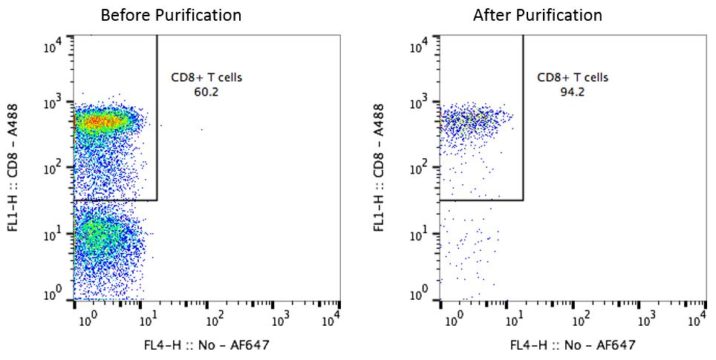
Figure 1. Purity of CD8 T cells after negative magnetic isolation from PBMCs. In this representation, cynomolgus PBMCs were incubated with antibodies against CD4 T cells, B cells, NK cells, dendritic cells, monocytes, granulocytes, and erythrocytes and subjected to negative magnetic isolation to obtain untouched CD8 T cells. A small aliquot was taken after selection to evaluate post-sort purity (right). Percent of CD8+ cells in PBMCs is also shown (left).
Cryopreservation and storage
Purified CD8 T cells were cryopreserved carefully using iQ Biosciences’ cryopreservation protocol that ensures high viability (> 90%) after thawing.
Cells should be stored at < -120°C once they are received, such as within a liquid nitrogen tank (vapor phase).
Additional information
| Available Size(s) | |
|---|---|
| Cell Type | |
| Format | |
| Species | |
| Tissue Type | |
| Viability | > 90% |
We are happy to accommodate the following donor requests if inventory is available. Feel free to inquire prior to ordering, or specify your interest in the "Order notes" section during checkout and we will follow-up with your shortly after your order is processed:
- Single or multiple donors for a particular product (SKU). Indicate number of vials from each individual donor
- Donor-matched PBMCs
- Donor(s) with a higher percentage of the cells of interest, i.e., B cells, CD14+ cells, CD4+ cells, CD8+ cells, or NK cells (for PBMC products only)
We are Committed to Ethical Practices
iQ Biosciences’ primary cell products from non-human primates are collected under approved IACUC protocol, which was developed in consultation with the Attending Veterinarian and is consistent with current veterinary standards. The collection facility is AAALACi and PHS accredited, and all animal housing, handling, and research protocols are consistent with standards set forth by the Animal Welfare Act, NIH's Policy on Humane Care and Use of Animals and the Guide for the Care and Use of Animals. All animal housing and handling is done in such a way to minimize stress and risk of injury to the animal.
For US customers, we ship via FedEx Overnight Shipping. Shipping charges will vary per shipping address (based on ZIP code) and are estimated to be $140.
For international (non-US) customers, we work closely with you and our couriers to ensure all necessary documentation is in place for international shipments to significantly reduce the chance of delays at Customs. For the export of non-human primate samples, this includes preparing CITES permits, as well as any other documentation as required by country. Please submit an inquiry to orders@iqbiosciences.com for your estimated time of delivery and shipping charges.
Austria
Hölzel Diagnostika Handels GmbH
Tel: +49 221 126 02 66
Email: info@hoelzel.de
Web: https://www.hoelzel-biotech.com/
Canada
Cedarlane
Tel: +1 (289) 288-0001
Toll Free (North America): +1 (800) 268-5058
Fax: +1 (289) 288-0020
Email: sales@cedarlanelabs.com
Web: https://www.cedarlanelabs.com
China
BIOHUB INTERNATIONAL TRADE CO., LTD.
上海起发实验试剂有限公司
Address: Chuansha Rd #6619, Pudong, Shanghai, Zipcode: 201200 P.R.China
Tel: 0086-021-50724187
Phone: +86-15921799099
Fax: 0086-021-50724961
Email: sale3@78bio.com
Web: www.qfbio.com
European Union
Caltag Medsystems Ltd.
Email: office@caltagmedsystems.co.uk
Web: https://www.caltagmedsystems.co.uk
tebu-bio
Web: https://www.tebu-bio.com
Or Find a local contact
Germany
Hölzel Diagnostika Handels GmbH
Tel: +49 221 126 02 66
Email: info@hoelzel.de
Web: https://www.hoelzel-biotech.com/
Zageno
Web: https://zageno.com/
Ireland
2B Scientific Ltd
Tel: +44(0) 1869 238033
Fax: +44(0) 1869 238034
Email: sales@2BScientific.com
Web: https://www.2bscientific.com
India
Cell & Gene BioSolutions Pvt. Ltd.
#478 C, SLV Complex, Raghavendra Swamy Mutt Road
Opp. Turahalli Water Tank, Turahalli, Subramanyapura Post
Uttarahalli Hobli, Bengaluru-560061, Karnataka, India
Phone: +91 97317 14670
Phone: +91 98809 25033
Email: info@cgbios.com
Web: www.cgbios.com
Japan
Cosmo Bio Co., Ltd.
Tel: +81 (03) 5632 9610
Fax: +81 (03) 5632 9619
Email: nsmail@cosmobio.co.jp
Web: https://www.cosmobio.co.jp
Qatar
Sedeer Medical Services and Trading LLC
Tel: +974 4434 9191
Email: info@sedeer.com
Web: https://sedeer.com/
Singapore
Omnicell Pte Ltd
Tel: +65 6747 0201
Email: enquiry@omnicell.com.sg
Web: https://omnicell.com.sg/</a
South Korea
BioClone
Tel: +82-2-2690-0058
Email: bioclone@bioclone.co.kr
Web: http://www.bioclone.co.kr
Switzerland
Hölzel Diagnostika Handels GmbH
Tel: +49 221 126 02 66
Email: info@hoelzel.de
Web: https://www.hoelzel-biotech.com/
Taiwan
Hycell International Co. Ltd.
Tel: +886-2-2877-1122
Fax: +886-2-2876-1520
Web: http://www.hycell.com.tw
United Kingdom
2B Scientific Ltd
Tel: +44(0) 1869 238033
Fax: +44(0) 1869 238034
Email: sales@2BScientific.com
Web: https://www.2bscientific.com
Caltag Medsystems Ltd.
Tel: +44 (0)1280 827460
Fax: +44 (0)1280 827466
Email: office@caltagmedsystems.co.uk
Web: https://www.caltagmedsystems.co.uk
tebu-bio
Tel: +44 (0)1733 421880
Fax: +44 (0)1733 421882
Email: uk@tebu-bio.com
Web: https://www.tebu-bio.com
Zageno
Web: https://zageno.com/
United States
Fisher Scientific
Tel: 1-800-766-7000
Web: https://www.fishersci.com
Quartzy
Web: https://www.quartzy.com
VWR International
Tel: 1-800-932-5000
Web: https://www.vwr.com
Zageno
Web: https://zageno.com/
